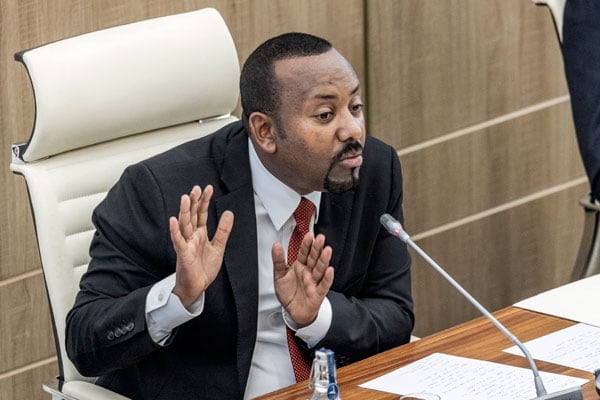By Dr. YONAS WORKINEH
Under Noble Peace prize winner, PM Abiy Ahmed, Ethiopia has been experiencing significant internal conflict, especially over the past few years.
Ethiopian Prime Minister Abiy Ahmed, initially hailed as a reformer and Nobel Peace Prize laureate for his efforts in ending the two-decade standoff with Eritrea, has seen his leadership embroiled in deepening ethnic tensions and civil strife.
Analyzing the situation requires a look at the complex political dynamics of Ethiopia, especially in the context of ethnic federalism and Abiy’s governance strategy.
Ethnic Federalism and Historical Grievances
Ethiopia is structured as an ethnic federation, where different ethnic groups, including the Amhara, Oromo, Tigrayans, and others, have semi-autonomous regional states.
This system was set up under the Ethiopian People’s Revolutionary Democratic Front (EPRDF), the ruling coalition before Abiy’s rise to power.
The system has long been criticized for fostering ethnic divisions and grievances.
The Amhara people, historically associated with Ethiopia’s imperial past, have at times felt marginalized under the EPRDF, which was dominated by the Tigrayan People’s Liberation Front (TPLF).
After Abiy came to power in 2018, promising reforms, the simmering tensions between various ethnic groups have often erupted into violence.
The Amhara community has been caught in the crossfire, not just between the government and the TPLF, but also in various localized ethnic conflicts.
The War with the TPLF
The war with the Tigray Peoples Liberation Front (TPLF) which began in November 2020, was devastating and left thousands dead, displacing millions.
Abiy’s government described the conflict as a “law enforcement operation” aimed at removing the TPLF from power in Tigray, following months of rising tensions and provocations.
The war, however, turned into a drawn-out and brutal conflict, marked by reports of atrocities committed by all sides, including the Ethiopian National Defense Forces (ENDF), Eritrean troops, and TPLF fighters.
The Amhara Region and Rising Violence
After the ceasefire with the TPLF in 2022, conflict has increasingly centered around the Amhara region.
While the TPLF was the initial target, many Amhara feel that they are now under attack by the federal government. There are multiple layers to the conflict involving the Amhara:
Boundary Disputes: Amhara forces had entered parts of Tigray during the war, claiming territories that they believe were historically Amhara lands, such as Wolkait.
These regions are now points of contention, and the withdrawal of federal forces has left some Amhara vulnerable to retaliatory attacks.
Dissatisfaction with Abiy: Many Amhara accuse Abiy Ahmed of sidelining their interests while trying to consolidate power.
The government’s failure to fully address security concerns in Amhara and its perceived tilt toward appeasing the Oromo population—Abiy’s own ethnic group—has fueled distrust.
Ongoing Military Operations: In recent months, the Ethiopian government has been accused of launching military operations, including drone strikes, in the Amhara region under the pretext of restoring order. The use of heavy-handed tactics has resulted in civilian casualties, which has only exacerbated the situation.
Abiy Strategy: Rule by Division
Critics argue that Abiy Ahmed has adopted a “divide and rule” strategy, pitting ethnic groups against one another to weaken opposition to his administration.
By framing certain ethnic groups, including the Amhara, as threats to national stability or as obstacles to peace, the government has justified the use of force.
Drone strikes and the deployment of federal forces have been criticized as disproportionate, especially when civilians are affected.
Moreover, Abiy’s reluctance to engage in meaningful national dialogue has alienated various factions, including within his own Prosperity Party.
The Amhara Fano militia, once seen as a crucial ally during the TPLF war, has turned against the government, reflecting broader discontent.
Regional Implications
The conflict in Ethiopia has implications for the entire Horn of Africa. Instability in Ethiopia, a key player in the region, risks spilling over into neighboring countries.
The humanitarian toll of the violence, including displacement, food insecurity, and the destruction of infrastructure, has drawn international condemnation.
While the international community has pressured Abiy for peace talks, little has been done to address the underlying ethnic tensions and governance issues.
Conclusion: A Path Forward?
The continued targeting of the Amhara people and other groups reflects a deeper crisis within Ethiopia’s political system.
As long as ethnic federalism remains a source of division and as long as the government resorts to military solutions, peace will remain elusive.
National reconciliation, meaningful dialogue, and inclusive political reform are crucial to addressing the grievances of all communities, including the Amhara. Without these, Ethiopia risks further destabilization and prolonged conflict.
Abiy Ahmed’s leadership faces a critical test: whether he can steer Ethiopia toward peace and stability or whether his tactics will deepen the ethnic fractures that threaten to tear the country apart.

